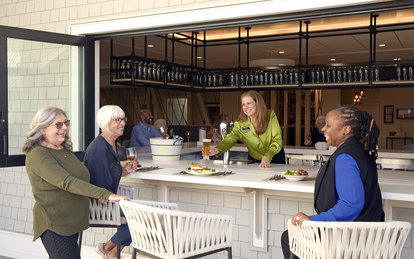Designing Connections: Can Architecture Help Solve for Loneliness in Senior Living?

In the forward to the 2023 report titled Our Epidemic of Loneliness and Isolation, the US Surgeon General Vivek Murthy, MD, stated, “Loneliness is far more than just a bad feeling—it harms both individual and societal health. It is associated with a greater risk of cardiovascular disease, dementia, stroke, depression, anxiety, and premature death. The mortality impact of being socially disconnected is similar to that caused by smoking up to 15 cigarettes a day, and even greater than that associated with obesity and physical inactivity.”
In our senior living communities, there are a multitude of social offerings, from small groups to large gatherings. Yet, according to the National Library of Medicine, 70% of those living in senior living communities report feelings of loneliness. How can this be when they are living in a community full of people? There is a fundamental difference between social isolation and loneliness. Social Isolation is objective. It is how many interactions one has. Loneliness, however, is subjective; it is one's perception of feeling alone. One can be lonely in a group and one can be alone, yet not lonely.
Loneliness is a biological response rooted in our evolutionary need to be part of a group. The need for community is instinctual; it is essential for survival. When we feel we do not belong, we experience loneliness. Research professor Brené Brown notes “Fitting in is about assessing a situation and becoming who you need to be to be accepted. Belonging, on the other hand, doesn’t require us to change who we are; it requires us to be who we are.” If the antidote to loneliness is belonging and perhaps even authenticity, how can we create communities where seniors feel a sense of belonging?
Okinawa, Japan, is one of the original Blue Zones, or longevity hotspots, where people live extraordinarily healthier and longer lives. One contributing factor is the social support system called the Moai, a group of five to six children who are paired together and commit to each other for life. They become a second family—lifelong friends from childhood into their advanced years. In contrast, when seniors elsewhere relocate into care communities, they often leave friends and families behind. They are placed with strangers and expected to create new friendships. For seniors to develop new friendships in a meaningful way, they must feel they belong. Can architecture help support and fuel this sense of belonging?
The Living Out project in Palm Springs, California, is an example of a strong community rich in social connections. The project was designed specifically to meet the needs and values of the LGBTQ community. How would our buildings change if we shaped them specifically to the people they intend to serve? Could we design buildings that focus not on population density, location and income but on authentic shared values?
Much like designing to a more specific human set of values, designing to a specific region creates a sense of place. Vernacular architecture is location-specific and unique, using traditional materials and resources from the area. It is contextual and responds to specific geographic features and cultural aspects of its surroundings. Vernacular architecture reaffirms regional identity. When we design cookie-cutter buildings and spread them across the country, our built environment becomes banal and homogenous, wiping out any sense of place.
Biophilic design is an approach that seeks to connect humans with nature, recognizing our innate love of living things. Creating environments that speak to our biophilic proclivity could help people feel they belong. When we create austere environments of functionality, we disconnect from nature. If we build environments rich in nature, might there be a biological response, the feeling of belonging, naturally?
Environments designed with specificity, deeply rooted in place with a strong biophilic presence may help create a sense of belonging. What are other ways that our designs can make people feel a part of something bigger than themselves?
Addressing the endemic loneliness in senior living communities requires more than just providing social opportunities; it necessitates fostering a genuine sense of belonging. By understanding the distinction between social isolation and loneliness, we can design better environments that serve the emotional and psychological needs of seniors. We can create spaces that emphasize authentic connections and shared values. Incorporating principles of vernacular and biophilic design can further enhance this sense of belonging by creating environments that are both contextually meaningful and naturally engaging.